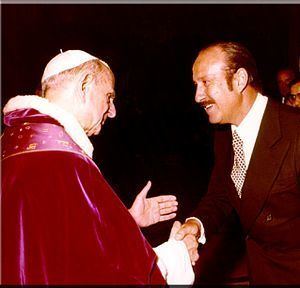Political party Independent Religion Greek Orthodox | Name Michel Sassine Role Politician | |
 | ||
Died August 2, 2014, Achrafieh, Lebanon | ||
Michel Georges Sassine (Arabic: ميشال جورج ساسين) was a prominent Lebanese politician. He was a member of the Lebanese parliament for twenty-four consecutive years (1968–1992) representing the district of Ashrafieh, Beirut. He served several times as Vice-Prime Minister, Deputy Speaker of Parliament, and cabinet Minister. He founded the Ministry of Housing and Cooperatives, and was appointed as Minister of Labor, Tourism and others in more than seven governments. Throughout his political career he was renowned for his strong ethics and anti-corruption principles. He took the lead on several historic turning points including the 1970 Presidential election, and the Taif Agreement in 1990.
Contents
- Personal life
- 1968 Parliamentary elections
- 1970 Presidential elections
- His relationship with President Camille Chamoun
- Role in Taif Agreement
- Other Achievements
- Association to Sassine Square
- References
Personal life
Sassine was born to a prominent Greek Orthodox family in Ashrafieh to parents Georges Sassine and Laurice Bustros. He lost his father in his teenage years and found himself in the responsibility of four other siblings including new-born twins. Sassine went to lead his family into politics, and together with his brothers Pierre and Joseph dedicated the family’s efforts to public service.
1968 Parliamentary elections
Michel Sassine was first elected to the Lebanese Parliament in 1968 running for the Greek Orthodox seat in the nation’s capital Beirut. Sassine ran alongside Nasri Maalouf and together, as independents, won against the government-backed coalition led by Sheikh Pierre Gemayel - including Minister of Foreign Affairs Fouad Boutros.
1970 Presidential elections
In the closest and possibly most controversial presidential election in Lebanese history, Suleiman Frangieh was elected President of the Republic by the National Assembly on 17 August 1970, with a majority of one single vote. The presidency being the most powerful political institution in pre-1990 Lebanon the presidential race was of particular importance as it came after 12 years of continuous Shihabist rule (Fuad Shihab 1958-1964, and Charles Helou, 1964–1970). The two main opposing candidates emerged to be Elias Sarkis – then Governor of the Central Bank – backed by the Shihabi regime; and Suleiman Frangieh backed by the opposition.
On the third voting round, Frangieh received majority by a single vote over Elias Sarkis. Sabri Hamadeh, then Speaker of Parliament and supporter of the Shihab regime, refused to announce the election of a President on such a low margin, and walked out of Parliament. Michel Sassine, Deputy Speaker of Parliament, stepped up and assumed the responsibilities of Speaker and announced Frangieh President in a move that saved the country of an inevitable political vacuum.
Sassine moved to serve as Minister and Vice-Prime Minister in the four different governments between 1972-1975 under the mandate of President Frangieh.
His relationship with President Camille Chamoun
Michel Sassine initially got elected as an independent and was never part of any political party throughout his career. Nevertheless, he developed a close political and personal relationship with President Camille Chamoun, and took a leading role in the National Liberal Party (Lebanon) (Al Ahrar) parliamentary block until the death of Chamoun's son Dany in 1990.
Role in Taif Agreement
Sassine was a signatory of the Taif Agreement that ended the Lebanese Civil War. He was serving as Deputy Speaker of Parliament when Parliament signed the agreement on 22 October 1989 and ratified it on 4 November 1989. In the post-Taif period Sassine was appointed Vice-Prime Minister and Minister of Labor in both the 1990-1992 governments of Salim al-Hoss, and Omar Karami.
Other Achievements
Association to Sassine Square
Sassine Square in Ashrafieh - the biggest and oldest square in Beirut – is one of the most prominent political, social and commercial focal points of the Lebanese capital. While Sassine Street was named after Michel Sassine’s father Georges in the 1940s’, Michel Sassine moved to get Sassine Square officially inaugurated in the early 90’s under the auspices of President Elias Hrawi and Prime-Minister Rafic Hariri.
